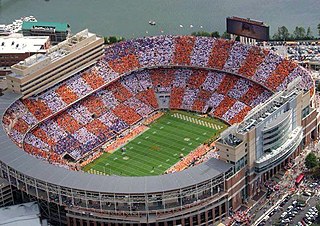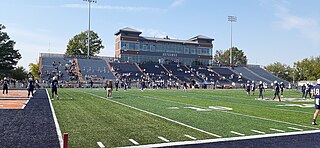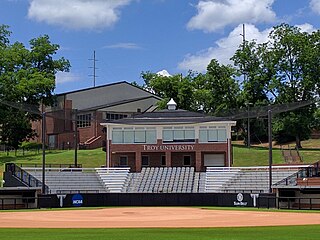
Neyland Stadium is a sports stadium in Knoxville, Tennessee, United States. It serves primarily as the home of the Tennessee Volunteers football team, but is also used to host large conventions and has been a site for several National Football League (NFL) exhibition games. The stadium's official capacity is 101,915. Constructed in 1921 as Shields–Watkins Field, the stadium has undergone 16 expansion projects, at one point reaching a capacity of 104,079 before being slightly reduced by alterations in the following decade. Neyland Stadium is the sixth largest stadium in the United States, the eighth largest stadium in the world, and the third largest stadium in the Southeastern Conference. The stadium is named for Robert Neyland, who served three stints as head football coach at the University of Tennessee between 1926 and 1952.

Darrell K Royal Memorial Stadium, located in Austin, Texas, on the campus of the University of Texas, has been home to the Longhorns football team since 1924. The stadium has delivered a home field advantage with the team's home record through November 24, 2023 being 399–122–10 (.761). The official stadium seating capacity is 100,119, making the stadium the fourth largest in the Southeastern Conference, the seventh largest stadium in the United States, and the ninth largest stadium in the world.

Memorial Stadium is a stadium in Bloomington, Indiana, United States. It is primarily used for football, and has been the home of Indiana Hoosiers football since its opening in 1960. It is the 15th largest football stadium in the Big Ten Conference, with a capacity of 52,626. The field has a conventional north-south alignment, at an approximate elevation of 771 feet (235 m) above sea level.

Veterans Memorial Stadium at Larry Blakeney Field is a stadium in Troy, Alabama. It is primarily used for American football, and is the home field of the Troy University Trojans. The seating capacity is 30,470. The stadium was originally built in 1950, and has regularly been expanded, renovated and improved since then. The stadium was named in honor of the college students and local residents who gave their lives during World War II. The field received its name from retired head coach Larry Blakeney, the coach with the most wins in Troy history.

Bill Snyder Family Stadium is a stadium in Manhattan, Kansas. It is used for American football, and is the home field of the Kansas State University Wildcats football team. It is named after the family of head coach Bill Snyder. Over the past 31 seasons – from 1990 through the 2022 season – K-State is 169–51–1 (.767) at home.

LaVell Edwards Stadium is an outdoor athletic stadium in the Western United States, on the campus of Brigham Young University (BYU) in Provo, Utah. Primarily used for college football, it is the home field of the BYU Cougars, a member of the Big 12 Conference in the Football Bowl Subdivision. Opened as "Cougar Stadium" in 1964, its seating capacity is 62,073. Following the 2024 departure of Oklahoma and Texas for the Southeastern Conference, it is the largest permanent stadium in the Big 12.

Eck Stadium is a baseball stadium in Wichita, Kansas, United States. It is located on the south side of 21st Street between Hillside and Oliver on the campus of Wichita State University in northeast Wichita.

Hancock Stadium is a 13,391-seat multi-purpose stadium in Normal, Illinois. It opened in 1963. It is home to the Illinois State University Redbirds football team as well as University High School. Central Catholic High School also played its games there through the 2004 season.
Bob Waters Field at E. J. Whitmire Stadium is a 13,742-seat football stadium in Cullowhee, North Carolina. It opened in 1974 and is home to the Western Carolina University Catamounts football team. The field itself is named Bob Waters Field. The football facility is located on the south end of the WCU campus and is bordered by Cullowhee Creek on the west side; Jordan-Phillips Field House and WCU Weight Room on its north end, and the Liston B. Ramsey Regional Activity Center on the south end.
Alfred A. McKethan Stadium at Perry Field was the college baseball stadium of the University of Florida, serving as the home field for the Florida Gators baseball team until being replaced by Condron Ballpark in 2020. McKethan Stadium was located on the university's Gainesville, Florida campus, in close proximity to the university's indoor sports arena, the Stephen C. O'Connell Center, and its football stadium, Ben Hill Griffin Stadium.

Hardy M. Graham Stadium is a 7,500-seat multi-purpose stadium in Martin, Tennessee. It is home to the University of Tennessee at Martin Skyhawks football team. The facility opened in 1964. It is located north of Tennessee State Route 431 from the central campus area, adjacent to the Ned McWherter Agricultural Complex.

Maverick Stadium is a 12,000-seat multi-purpose stadium on the western edge of University of Texas at Arlington campus.

Lubbers Stadium, or Arend D. Lubbers Stadium, is a stadium on the Grand Valley State University's main campus in Allendale, Michigan, USA. The stadium was named after former university president Arend Lubbers. It is primarily used for American football, and is the home field of the Grand Valley State Lakers. "Lakers Stadium" - as it was originally known - was constructed in 1972, and opened in 1973. It now officially seats 10,444 people - though it almost always holds thousands more fans. The stadium is also home to a football offices and weight training facility.

Joan C. Edwards Stadium, formerly Marshall University Stadium, is a football stadium located on the campus of Marshall University in Huntington, West Virginia, United States. It currently can hold 30,475 spectators and includes twenty deluxe, indoor suites, 300 wheelchair-accessible seating, a state-of-the-art press-box, 14 concession areas, and 16 separate restrooms. It also features 90,000 sq ft (8,000 m2) of artificial turf and 1,837 tons of structural steel. It also houses the Shewey Athletic Center, a fieldhouse and a training facility. The new stadium opened in 1991 and replaced Fairfield Stadium, a condemned off-campus facility built in 1927 in the Fairfield Park neighborhood.

Olga Mural Field at Schoonover Stadium is a baseball venue located on the campus of Kent State University in Kent, Ohio, United States. It is home to the Kent State Golden Flashes baseball team, a member of the National Collegiate Athletic Association (NCAA) in Division I and the Mid-American Conference East Division. The field opened in 1966 and was previously known as Gene Michael Field from 1990 to 2003. The field was renamed in late 2003 and renovated in 2005 with additional upgrades made from 2006 through 2008 and again in 2013 to 2014. It has a seating capacity of 1,148 people with a Shaw Sports Turf synthetic playing surface.
Raymond C. Hand Park is a baseball venue in Clarksville, Tennessee, United States. It is home to the Austin Peay Governors baseball team of the NCAA Division I Atlantic Sun Conference. The facility has a seated capacity of 777 spectators, with a total capacity of over 1,000. The facility opened on March 23, 1970, and is named for Clarksville businessman Raymond C. Hand.

The Troy Softball Complex, built in 2002 on the campus of Troy University, is the home stadium for the Division I (NCAA) Troy Trojans softball team. In 2014, the entire complex underwent a $3 million renovation project. The official seating capacity is 800, with 120 of the seats being chairback seating. The Dodd Center was built in 2014 during the renovation, which houses coaches offices, player lounge, and locker rooms, and indoor batting cages. In the opening game of 2014, Troy hosted Auburn at the newly renovated field, finishing in a 5–5 tie with the Tigers.
The 2021 Austin Peay Governors football team represented Austin Peay State University during the 2021 NCAA Division I FCS football season as a member of the Ohio Valley Conference (OVC). They were led by second-year head coach Scotty Walden and played their games at Fortera Stadium in Clarksville, Tennessee.
The 2023 Austin Peay Governors football team represented Austin Peay State University as a member of the United Athletic Conference during the 2023 NCAA Division I FCS football season. Led by fourth-year head coach Scotty Walden, the Governors played at Fortera Stadium in Clarksville, Tennessee.
The 2024 Austin Peay Governors football team represented Austin Peay State University as a member of the United Athletic Conference (UAC) during the 2024 NCAA Division I FCS football season. The Governors were coached by first-year head coach Jeff Faris and played at Fortera Stadium in Clarksville, Tennessee.















